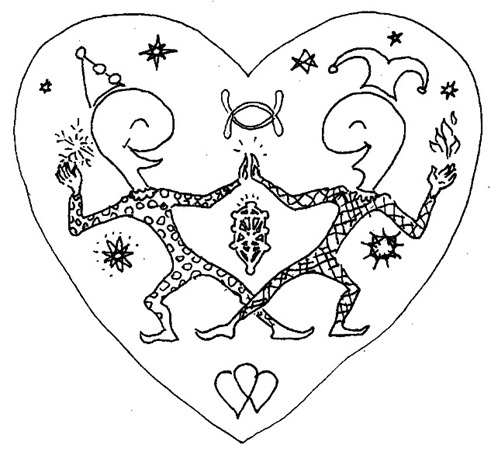Adam Blatner
Words and Images from the Mind of Adam Blatner
Collaborative Creativity through Psychodrama
Originally posted on July 25, 2013
The drawing below represents my vision of the way people can join in co-creating a more loving and joyous universe.
Although two people are shown, and the symbol of encounter is between them, really any number can co-create. They are different—they offer their own angles on whatever is in formation. There is a playful liberation of what needs to come into being through a mixture of the out-of-control processes of fire and insight, the flame and spark in their outstretched hands. That symbol between them is the kabbalistic “tree of life,” a reminder of the Source—Moreno called it “metapraxie.” It’s beyond, and they open to, and surrender to, inspiration.
As it comes through, they add their individuality in bringing it into focus or form. These are the little mandalas under their outer arms—and though they are slightly different, they can serve as a “yes-and” rather than a “no-but” that builds new syntheses rather than argues for this over and against that.
I use the theme of psychodrama because it’s a root form that at its essence involves, first, the goal of creativity, and the value of re-creation, the need, indeed, for creating anew, in light of all the other new creations. Second, it supports the vehicle of spontaneity, improvisation, play, exploration, as significant vehicles of creativity. Third, it supports the idea of doing, action, enactment, and collaboration, as ways to achieve the second goal and from that support creativity. Fourth, it dips back into remembering a deeper philosophical orientation that recognizes that this whole deal isn’t just for a narrower purpose—though it might do for that, too—but that this is what it’s all about, everywhere, ultimately.
In a broader sense, then, when I use the term psychodrama, I simply harken back to Moreno’s vision that really transcended actual dramatic enactment—which is indeed one approach to this—but in a larger sense, so is improvisation in singing, all the arts, and even in the structuring of organizations and tasks; and in a larger sense, all this is connected to all efforts to re-think, re-create, reassert the process of change.
(Not all proposals for change are wise, let me acknowledge. Sometimes this process of re-creating involves more active efforts at reasserting that what is already in use continues to be better for various reasons than what is proposed as creative or new. Some of these proposals or trends are foolish. But ultimately, conservativism at best conserves what is best, and is not just stubborn overall resistance to change. So the process of evolution continues.)

Leave a Reply